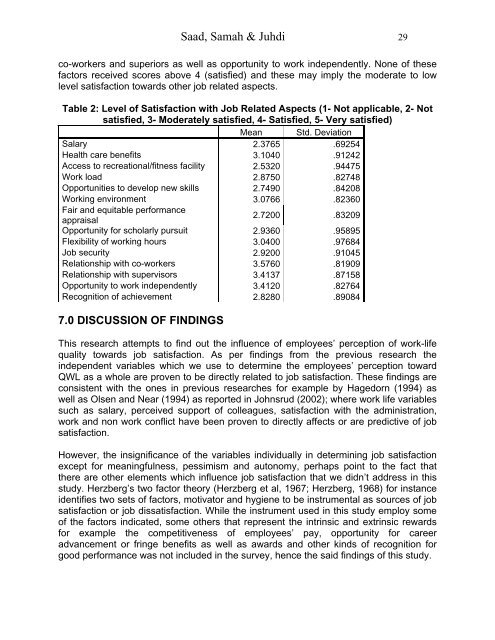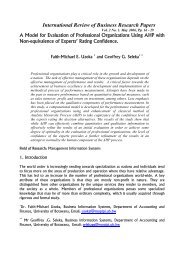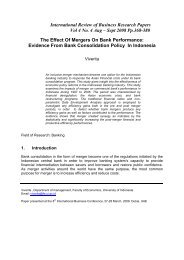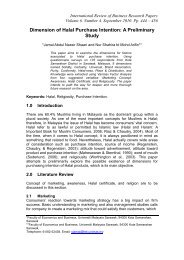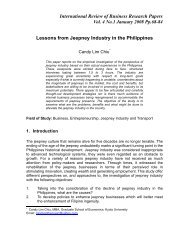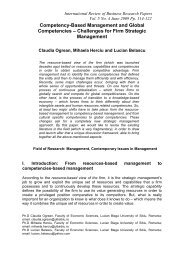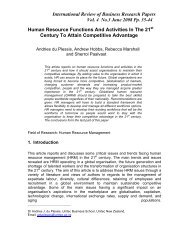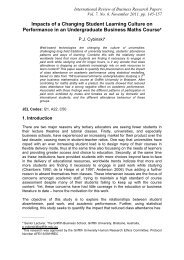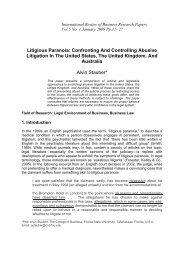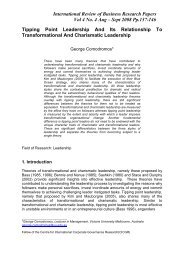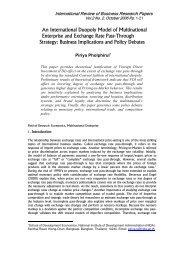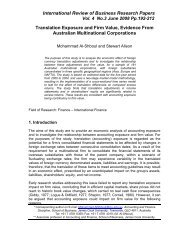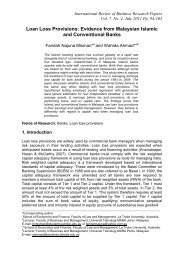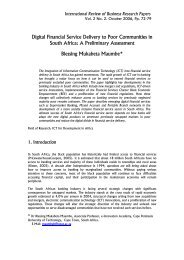Employees' Perception on Quality Work Life and Job Satisfaction
Employees' Perception on Quality Work Life and Job Satisfaction
Employees' Perception on Quality Work Life and Job Satisfaction
You also want an ePaper? Increase the reach of your titles
YUMPU automatically turns print PDFs into web optimized ePapers that Google loves.
Saad, Samah & Juhdi 29co-workers <strong>and</strong> superiors as well as opportunity to work independently. N<strong>on</strong>e of thesefactors received scores above 4 (satisfied) <strong>and</strong> these may imply the moderate to lowlevel satisfacti<strong>on</strong> towards other job related aspects.Table 2: Level of Satisfacti<strong>on</strong> with <strong>Job</strong> Related Aspects (1- Not applicable, 2- Notsatisfied, 3- Moderately satisfied, 4- Satisfied, 5- Very satisfied)Mean Std. Deviati<strong>on</strong>Salary 2.3765 .69254Health care benefits 3.1040 .91242Access to recreati<strong>on</strong>al/fitness facility 2.5320 .94475<strong>Work</strong> load 2.8750 .82748Opportunities to develop new skills 2.7490 .84208<strong>Work</strong>ing envir<strong>on</strong>ment 3.0766 .82360Fair <strong>and</strong> equitable performanceappraisal2.7200 .83209Opportunity for scholarly pursuit 2.9360 .95895Flexibility of working hours 3.0400 .97684<strong>Job</strong> security 2.9200 .91045Relati<strong>on</strong>ship with co-workers 3.5760 .81909Relati<strong>on</strong>ship with supervisors 3.4137 .87158Opportunity to work independently 3.4120 .82764Recogniti<strong>on</strong> of achievement 2.8280 .890847.0 DISCUSSION OF FINDINGSThis research attempts to find out the influence of employees’ percepti<strong>on</strong> of work-lifequality towards job satisfacti<strong>on</strong>. As per findings from the previous research theindependent variables which we use to determine the employees’ percepti<strong>on</strong> towardQWL as a whole are proven to be directly related to job satisfacti<strong>on</strong>. These findings arec<strong>on</strong>sistent with the <strong>on</strong>es in previous researches for example by Hagedorn (1994) aswell as Olsen <strong>and</strong> Near (1994) as reported in Johnsrud (2002); where work life variablessuch as salary, perceived support of colleagues, satisfacti<strong>on</strong> with the administrati<strong>on</strong>,work <strong>and</strong> n<strong>on</strong> work c<strong>on</strong>flict have been proven to directly affects or are predictive of jobsatisfacti<strong>on</strong>.However, the insignificance of the variables individually in determining job satisfacti<strong>on</strong>except for meaningfulness, pessimism <strong>and</strong> aut<strong>on</strong>omy, perhaps point to the fact thatthere are other elements which influence job satisfacti<strong>on</strong> that we didn’t address in thisstudy. Herzberg’s two factor theory (Herzberg et al, 1967; Herzberg, 1968) for instanceidentifies two sets of factors, motivator <strong>and</strong> hygiene to be instrumental as sources of jobsatisfacti<strong>on</strong> or job dissatisfacti<strong>on</strong>. While the instrument used in this study employ someof the factors indicated, some others that represent the intrinsic <strong>and</strong> extrinsic rewardsfor example the competitiveness of employees’ pay, opportunity for careeradvancement or fringe benefits as well as awards <strong>and</strong> other kinds of recogniti<strong>on</strong> forgood performance was not included in the survey, hence the said findings of this study.


